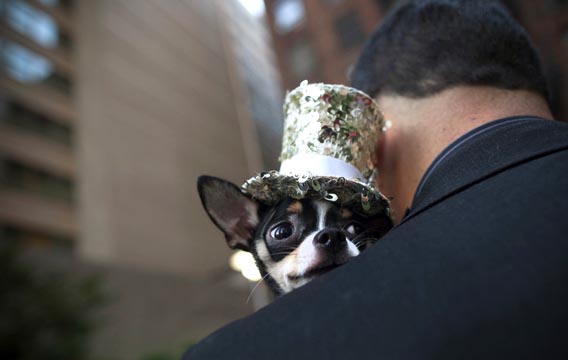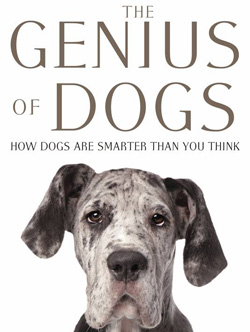 Bogie the Chihuahua peers over his owner Anthony Rubio's shoulder as he awaits his turn at the "Furry Friends on the Runway" doggie fashion event at the Ritz Plaza Park in New York, Sept. 5, 2012.
Bogie the Chihuahua peers over his owner Anthony Rubio's shoulder as he awaits his turn at the "Furry Friends on the Runway" doggie fashion event at the Ritz Plaza Park in New York, Sept. 5, 2012. Photo by Andrew Kelly/Reuters
The wolves that were social enough to approach human settlements and eat our ancestors' scraps evolved into man's best friend. Evolutionary anthropologist Brian Hare tells Tiffany O'Callaghan what dogs reveal about our own evolution. Hare runs Duke University's Canine Cognition Center. He is co-author with Vanessa Woods of The Genius of Dogs. They recently launched the website dognition.com.
Tiffany O?Callaghan: You set out to study human evolution. How did you end up studying dogs?
Brian Hare: One thing that equipped humans to acquire language was our ability to read gestures. My undergraduate adviser at Emory University, Mike Tomasello, was exploring the hypothesis that this might be unique to our species. He was telling me that our closest relatives, the chimpanzees and bonobos, are not good at reading gestures the same way that we are in a cooperative context. I said, "Wait a second, I think my dog can pass the same test the apes are failing." That's how it got started.
TO: How can dogs teach us more about ourselves?
BH: The dog is the only species we've found that has some of the communicative skills that look like what infants need to acquire language and culture. So what in the world are they doing in dogs? And what evolutionary process allowed that to happen? If we can figure out how it happened in dogs, it helps us figure out how our own species evolved.
TO: Tell me about the similarities between dogs and human infants.
BH: Dogs are the only species that have been identified to date that learn words in the same way as human children?by using inferences. Show a child a red block and a green block, for example. If you then ask for "the chromium block, not the red block," most children will give you the green block, despite not knowing that "chromium" can refer to a shade of green. The child infers the name of the object. Dogs have been found to learn in the same way.
The second thing is that they make use of human gestures at a similar level of flexibility to young infants. Obviously older infants quickly outstrip what dogs can do, but the fact that there is any overlap at all is remarkable.
TO: How do you test a dog's ability to infer?
BH: One example is a simple game in which you hide food in one of two places, then show the dog the place where the food is not. They have to make an inference: If it's not there it must be the other place. They also can make social inferences. When you're pointing, for instance, they're inferring what you want, what direction it is you're suggesting they go.

Courtesy of Penguin Publishing
TO: How do dogs compare with other animals in their ability to make inferences?
BH: There are lots of flavors of intelligence. Researchers have looked at different animals and the contexts in which they are able to make inferences. Corvids, the family of birds that includes crows and ravens, make incredibly complicated inferences when it comes to using tools or outcompeting group members in hiding food, for example. What's special about dogs is that they have the ability to figure out what we want, to use humans as a tool in a way that other animals cannot.
The way that I would love for people to think about intelligence is to think of a tool box. If somebody asks you what's the smartest species or who's the smartest person, it's the equivalent of asking, what's the best tool, a hammer or a screwdriver? Well, what's the problem you're trying to solve? What is it that dogs need to solve to survive? They need to figure out how to use humans effectively.
TO: So what was it that set some wolves on the road to using humans?
BH: The folk-psychological notion of domestication is that dogs were created in our image. That 12,000 to 15,000 years ago some foraging human populations who were transitioning to agriculture raised wolves and intentionally bred them over many generations. Bearing in mind that wolves are aggressive toward people generally, eat a lot, and eat the same things that we eat, that story doesn't make much sense.
TO: So how did self-domestication take place?
BH: It's the same way that squirrels go to your bird feeder, or mice come into your house. Dogs did not evolve because humans chose to do it. It happened because a population of wolves one day spotted an easy meal?the garbage lying around where the humans were.
Those wolves would have been more friendly toward humans, tolerant and bold. The wolves exploiting that food resource then spent more time together and mated. You end up having human-friendly wolves breeding together.
Source: http://feeds.slate.com/click.phdo?i=7c28bc402297a6b3dd1d7a52afeb01d3
Columbus Day 2012 carlina white Sam Champion Engaged Infield fly rule Taken 2 Venezuela Elections Skyfall
No comments:
Post a Comment
Note: Only a member of this blog may post a comment.